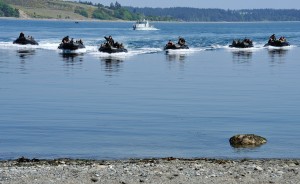It’s hard to appreciate the ambition of JOINTEX 13. Not only did Stage 5 involve a complex web of live and simulated activities, dispersed across a federated network from Victoria to Halifax, it also integrated three large, live annual training exercises conducted by the Army, (Maple Resolve), the Navy (Trident Fury) and the Air Force (Maple Flag).
While those three force generation exercises produce the combat capacity the Canadian Armed Forces require for operations, they don’t fully replicate all the headquarters connectivity, intelligence requirements and sustainment functions that underpin any operation.
However, bolting together those three live training events, which had already been planned months before, with a largely simulation-based environment that emphasized the command and control (C2), intelligence and sustainment aspects of operations was a huge challenge.
“It was not the ideal way to do it,” acknowledge Colonel Ken Chadder, recently retired as commander of the Canadian Forces Warfare Centre (CFWC) and the exercise director of JOINTEX 13. “Normally you would have done it the other way around. We wanted to be non-disruptive so the intent was to take what the services had in their scenarios, adjust it to fit in ours, and then create the link between the various headquarters. In some cases it went really well, in others … but I think we showed everybody this is where we need to be going.”
While organizers made a conscious decision to keep the first JOINTEX largely a Canadian affair, with limited international participation, the event attracted the attention of the U.S Director Joint Force Development (J7), who, impressed by the level of ambition, sent senior people to observe. “He said, ‘We don’t even do that. Let us know when you do this again because we want to play’,” Chadder said.
The JOINTEX scenario integrated land, air, maritime and special forces into a coalition operation that included Canadian command of multinational forces in its area of responsibility. The operations in a fictitious failed state included enforcement of a maritime exclusion zone, the establishment of air superiority that was later lost with the intervention of a third country and had to be regained, as well as the movement of three army divisions.
The mix of live, virtual and constructive players and equipment all operating in a shared environment created a unique level of reality for both the CJIATF headquarters in Wainwright and the national command in Ottawa.
A critical lesson learned during Stage 4 was the number of people required to provide key information between the two headquarters. For Stage 5, the number of personnel in the CJIATF dedicated to satisfying CJOC information requirements increased from 10 to 40. “We realized you can’t play that, there are too many activities going back and forth,” Chadder explained. “Now that we understand what that looks like, we will exercise that in RIMPAC and we will be much better prepared for 2015.”
In fact, despite the complexity of Stage 5, the real challenge was Stage 4. “Compared to the problems we had on 4, I didn’t lose anywhere near as much sleep,” Chadder admitted. Activated in short order, the computer assisted command post exercise, dispersed over numerous locations, tested many of the headquarters communications, intelligence and sustainment systems that would feature prominently in Stage 5. “It was a huge feat because it had never been done before,” Chadder said. “It was a credit to all the technical folks in the various organizations.”
Chadder added that the presence of LGen (retired) Charlie Bouchard in both stages as role-playing commander of coalition forces and actual mentor to MGen John Collin, commander of 1st Cdn Div HQ and the commander of the CJIATF in both exercises, “added a level of realism that I have never seen in any exercise before in my 36 years.”
The event also highlighted the strength of the warfare centre. Stood up in 2010 as a joint capability development innovation centre and test bed for the CF, it had lacked a vocal supporter. Integrated into CJOC in June, the centre now has a champion to ensure its technical capacity and doctrine, lessons learned and experimentation capability continue to grow. Of note, it took the lead in developing the technical architecture for the CAF’s targeting requirement, something that had been a problem in Stage 4.

